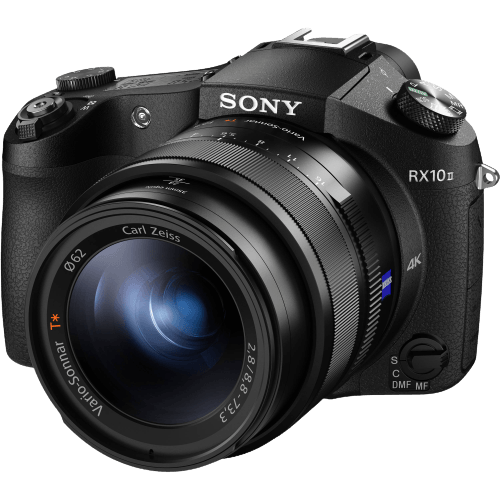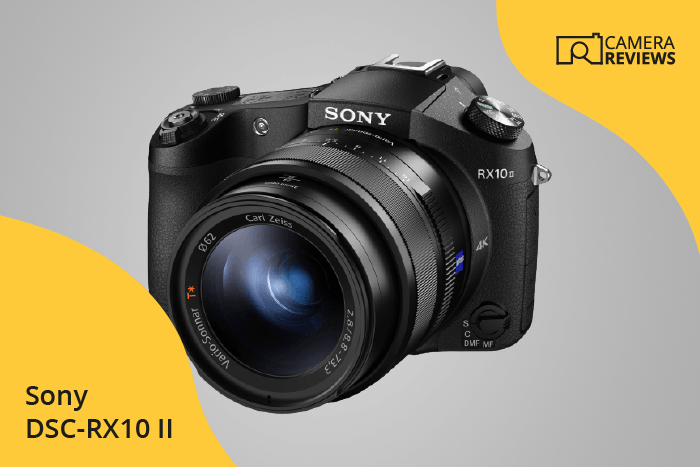Sony Cyber-shot DSC-RX10 II Specs and Scores

The Sony Cyber-shot DSC-RX10 II receives a score of 59/100. Announced on October 6, 2015, and released the same year, this bridge camera initially cost $1,299. It measures 129 x 88 x 102mm and weighs 813g or 1.79lbs. Considering its age and the rapid advancement of camera technology, the DSC-RX10 II’s specifications may not be as competitive in today’s market. However, for those looking for a reliable and solidly built camera, this model still holds its own.
Sony Cyber-shot DSC-RX10 II Overview and Optics
The Sony Cyber-shot DSC-RX10 II receives an optics score of 64/100. This camera boasts 20 megapixels and a shooting speed of 14 frames per second, making it competitive in the market. The DSC-RX10 II is equipped with a CMOS sensor, a Bionz X processor, and a DXOMARK sensor score of 70, which contribute to its overall performance.
The sensor size of 1″ is standard for this type of camera, and the 3:2 aspect ratio ensures quality image composition. While the fixed lens mount means users cannot change the lens, the camera does feature image stabilization, which helps reduce blur and improve image clarity.
Considering these specifications, the Sony Cyber-shot DSC-RX10 II has solid optical capabilities. Although it may not be the highest-scoring camera in today’s market, it remains a reliable choice for new photographers seeking quality performance.
Sony Cyber-shot DSC-RX10 II Video Performance
The Sony Cyber-shot DSC-RX10 II boasts a video score of 77/100, which is a strong indication of its capabilities in this category. The camera offers a maximum video resolution of 4K, with dimensions of 3840 x 2160, placing it among the top contenders in today’s market for video performance. Additionally, it supports a maximum video frame rate of 120fps, which enables users to capture smooth and detailed footage.
However, one notable drawback is the lack of built-in time-lapse functionality. This feature is becoming increasingly popular among photographers and videographers, and its absence may be a deciding factor for some potential buyers. Despite this limitation, the Sony Cyber-shot DSC-RX10 II remains a solid choice for those seeking a camera with impressive video capabilities.
Sony Cyber-shot DSC-RX10 II Features and Benefits
The Sony Cyber-shot DSC-RX10 II receives a feature score of 57 out of 100. This score suggests that the camera’s features are somewhat limited compared to other options in the market. The camera has a 3-inch screen with a resolution of 1228800 dots, but it does not have a touchscreen. Additionally, it does not offer a flip screen, which may be a downside for vloggers or selfie enthusiasts.
The camera is not equipped with GPS, but it does have WIFI and Bluetooth capabilities, allowing users to connect with devices and share their photos more easily. Despite some limitations, the Sony Cyber-shot DSC-RX10 II is still a decent choice for those who prioritize connectivity over other features.
Taking these specifications into account, the camera holds its place in the market, but it may not be the best choice for those seeking a more feature-rich option. Users should weigh their priorities and consider other models if touchscreen, flip screen, or GPS functionalities are essential.
Sony Cyber-shot DSC-RX10 II Storage and Battery
The Sony Cyber-shot DSC-RX10 II receives a storage and battery score of 24/100. This camera has one memory card slot that accepts SD, SDHC, SDXC, Memory Stick Duo, Pro Duo, and Pro-HG Duo cards. In today’s market, a single memory card slot is less competitive as cameras increasingly offer dual slots for flexibility and backup purposes.
The camera’s battery life allows for 400 shots per charge, powered by an NP-FW50 battery. However, it does not have USB charging capabilities. This battery life is adequate but not exceptional in comparison to other cameras on the market.
Taking these factors into account, the Sony Cyber-shot DSC-RX10 II’s storage and battery capabilities are decent but not outstanding.
Sony Cyber-shot DSC-RX10 II Alternatives
Do you want to know how the Sony Cyber-shot DSC-RX10 II compares to its competitors? Try our camera comparison tool to compare specs side by side! If you’re not sure where to start, have a look at some popular comparisons for inspiration:
- Ricoh GR III vs Sony Cyber-shot DSC-RX100 VII
- Canon PowerShot ELPH 190 IS vs Sony Cyber-shot DSC-W800/B
- Sony Cyber-shot DSC-RX10 vs Cyber-shot DSC-RX10 II
- Fujifilm X100T vs Sony Cyber-shot DSC-RX1
- Sony Cyber-shot DSC-RX1 vs Cyber-shot DSC-RX1R
- Canon PowerShot ELPH 180 vs Sony Cyber-shot DSC-W800/B
- Panasonic Lumix DMC-GH4 vs Sony Cyber-shot DSC-RX10
- Sony a7R III vs Cyber-shot DSC-RX1R II
Sony Cyber-shot DSC-RX10 II FAQ
Does the Sony Cyber-shot DSC-RX10 II Have Built-in Image Stabilization?
Yes, the Sony Cyber-shot DSC-RX10 II features built-in Optical SteadyShot image stabilization, which helps minimize camera shake and produce sharper images, especially in low-light situations or when using the telephoto end of the zoom range.
Does the Sony Cyber-shot DSC-RX10 II Support 4K Video Recording?
Yes, the Sony Cyber-shot DSC-RX10 II supports 4K video recording at 30fps, providing high-resolution and high-quality videos with rich details, making it an excellent choice for videographers and content creators.
What Size Sensor Does The Sony Cyber-shot DSC-RX10 II Have?
The Sony Cyber-shot DSC-RX10 II is equipped with a 1-inch Exmor RS stacked CMOS sensor, offering excellent image quality, low-light performance, and fast readout speeds for both stills and video recording.
Does the Sony Cyber-shot DSC-RX10 II Have a Dual Memory Card Slot?
No, the Sony Cyber-shot DSC-RX10 II has a single memory card slot that supports SD, SDHC, and SDXC cards, as well as Sony’s Memory Stick Duo format.
Does the Sony Cyber-shot DSC-RX10 II Have a Touch Screen?
No, the Sony Cyber-shot DSC-RX10 II does not feature a touch screen. However, it has a tiltable 3-inch LCD screen with a resolution of 1,228,800 dots for easy viewing and menu navigation.
Does the Sony Cyber-shot DSC-RX10 II Have Wi-Fi and Bluetooth?
Yes, the Sony Cyber-shot DSC-RX10 II offers built-in Wi-Fi and NFC (Near Field Communication) connectivity for easy wireless sharing and remote control functionality, but it does not have Bluetooth.
Does the Sony Cyber-shot DSC-RX10 II Have GPS?
No, the Sony Cyber-shot DSC-RX10 II does not have built-in GPS capabilities for geotagging your images.
Is the Sony Cyber-shot DSC-RX10 II Weather Sealed?
No, the Sony Cyber-shot DSC-RX10 II is not weather sealed, meaning it is not designed to withstand harsh weather conditions, such as rain or extreme temperatures.
Does the Sony Cyber-shot DSC-RX10 II Have a Built-in Flash?
Yes, the Sony Cyber-shot DSC-RX10 II features a built-in pop-up flash, providing additional illumination when shooting in low-light situations or to fill in shadows.

